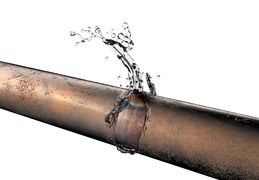Water leaks are one of the most destructive and frustrating problems in many Lansdale homes. Undetected water leaks can rot wood, destroy drywall, and cause mold to grow in unseen spaces of your home. Spending the time and money to find and fix water leaks before they cause significant damage is one of the most cost-effective actions a homeowner can take.
Sinks
Cabinets beneath kitchen and bathroom sinks are a good place to start. Look for signs of water damage or build up. Mold and mildew are telltale signs of water leaks. Touch the pipes, particularly the areas where they enter the faucet. Run the hot and cold water faucets for a few minutes and repeat the inspection. Finally, fill the sink with water, let it stand a few minutes and open the drain. Now check the drain pipe and the joints that connect it to the sink for leaks.
Dishwashers
Dishwashers can’t easily be checked for leaks without pulling them out from beneath the counter. But you can inspect the water lines that connect the dishwasher to the kitchen sink. For some units, you may be able to shine a flashlight beneath the dishwasher to look for puddles.
Toilets
Toilets can leak from the water supply pipes filling the tank and from the seal between the toilet and the waste pipe in the floor. Flush the toilet several times and carefully look for any signs of leaks in the joints of the water supply pipe and the floor around the base of the toilet. Lift the lid off the tank and flush the toilet. When the tank refills, the water should completely shut off. If the flush valve or water control unit is old, corroded, or loose, the water will continue to run. Running water cools the water delivery pipe to the toilet and the tank, which will cause them to collect condensation in humid weather. The condensation will drip and eventually cause water damage to the floor behind the toilet. Bottom line – don’t ignore a running toilet. Have the water control and flush valve fixed or replaced.
Tubs and Showers
Inspect the caulking around the tub or shower. Old, cracked, or missing caulking can allow water to leak into the wall. Water dripping from a leaky faucet or shower head will go down the drain and not cause any damage, but the faucet may also be leaking water behind the tub or shower.
Hot Water Heaters
Finally, inspect the hot water heater for leaks, and the boiler if the house has hot water heating. The first place to look is the floor around the appliance, but also look at the joints where the water pipes connect.
If you need any help with leak detection or any other problems with your Lansdale plumbing, give Carney Plumbing Heating & Cooling a call!
Continue Reading
Tags: Hatfield, Lansdale, Leak Detection, Line Lexington, Plumbing, Plumbing Repair
Posted in Plumbing | Comments Off on Fix Water Leaks Before They Cause Major Damage
 One of the big problems with hidden leaks in a home’s plumbing is that they’re … hidden. People often won’t know they’re there until they begin to cause trouble. And make no mistake, hidden leaks can cause plenty of trouble—probably much more so than you imagine.
One of the big problems with hidden leaks in a home’s plumbing is that they’re … hidden. People often won’t know they’re there until they begin to cause trouble. And make no mistake, hidden leaks can cause plenty of trouble—probably much more so than you imagine.
